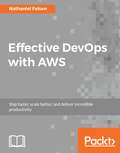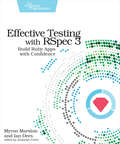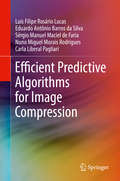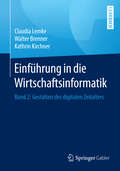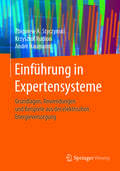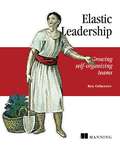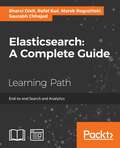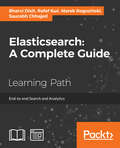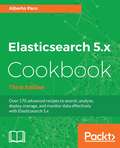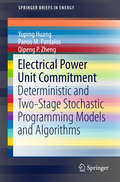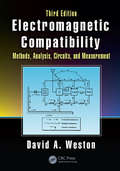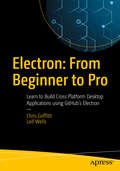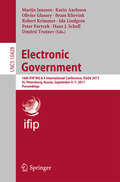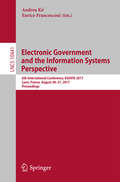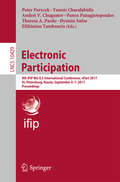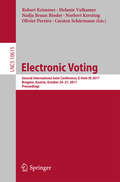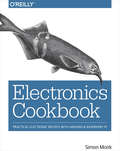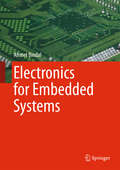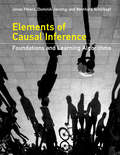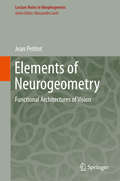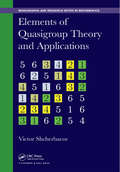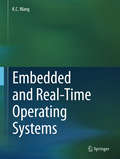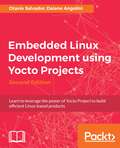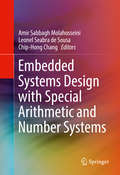- Table View
- List View
Effective DevOps with AWS: Implement Continuous Delivery And Integration In The Aws Environment, 2nd Edition
by Nathaniel FelsenScale gracefully and maintain outstanding performance with your AWS-based infrastructure using DevOps principles About This Book • Implement DevOps principles to take full advantage of the AWS stack and services • Take expert look at solving problems faced by real developers and operation teams and learn to overcome them • Learn from expert insights of the author who has worked with Silicon Valley's most high-profile companies Who This Book Is For This book is for developers, DevOps engineers and teams who want to build and use AWS for their software infrastructure. Basic computer science knowledge is required for this book. What You Will Learn • Find out what it means to practice DevOps and what its principles are • Build repeatable infrastructures using templates and configuration management • Deploy multiple times a day by implementing continuous integration and continuous deployment pipelines • Use the latest technologies, including containers and serverless computing, to scale your infrastructure • Collect metrics and logs and implement an alerting strategy • Make your system robust and secure In Detail The DevOps movement has transformed the way modern tech companies work. AWS which has been on the forefront of the Cloud computing revolution has also been a key contributor of this DevOps movement creating a huge range of managed services that help you implement the DevOps principles. In this book, you'll see how the most successful tech start-ups launch and scale their services on AWS and how you can too. Written by a lead member of Mediums DevOps team, this book explains how to treat infrastructure as code, meaning you can bring resources online and offline as necessary with the code as easily as you control your software. You will also build a continuous integration and continuous deployment pipeline to keep your app up to date. You'll find out how to scale your applications to offer maximum performance to users anywhere in the world, even when traffic spikes with the latest technologies, such as containers and serverless computing. You will also take a deep dive into monitoring and alerting to make sure your users have the best experience when using your service. Finally, you'll get to grips with ensuring the security of your platform and data. Style and approach This is a practical, hands-on, comprehensive guide to AWS, helping readers understand AWS in a step by step manner.
Effective Testing with RSpec 3: Build Ruby Apps with Confidence
by Myron Marston Ian Dees"Our tests are broken again!" "Why does the suite take so long to run?" "What value are we getting from these tests anyway?" Solve your testing problems by building and maintaining quality software with RSpec - the popular BDD-flavored Ruby testing framework. This definitive guide from RSpec's lead developer shows you how to use RSpec to drive more maintainable designs, specify and document expected behavior, and prevent regressions during refactoring. Build a project using RSpec to design, describe, and test the behavior of your code. Whether you're new to automated tests or have been using them for years, this book will help you write more effective tests. RSpec has been downloaded more than 100 million times and has inspired countless test frameworks in other languages. Use this influential Ruby testing framework to iteratively develop a project with the confidence that comes from well-tested code. This book guides you through creating a Ruby project with RSpec, and explores the individual components in detail. Start by learning the basics of installing and using RSpec. Then build a real-world JSON API, using RSpec throughout the process to drive a BDD-style outside-in workflow. Apply an effective test strategy to write fast, robust tests that support evolutionary design through refactoring. The rest of the book provides the definitive guide to RSpec's components. Use rspec-core's metadata to slice and dice your spec suite. Dig into rspec-expectations' matchers: compose them in flexible ways, specify expected outcomes with precision, and diagnose problems quickly with the help of good failure messages. Write fast, isolated tests with rspec-mocks' test doubles while pushing your code toward simpler interfaces. The authors, with a combined 20 years of automated testing experience, share testing wisdom that will lead to a fun, productive testing experience. What You Need: To follow along with the book, you'll need Ruby 2.2+. The book will guide you through installing RSpec 3 and setting up a new project to use it.
Efficient Predictive Algorithms for Image Compression
by Luís Filipe Rosário Lucas Eduardo Antônio Barros da Silva Sérgio Manuel Maciel de Faria Nuno Miguel Morais Rodrigues Carla Liberal PagliariThis book discusses efficient prediction techniques for the current state-of-the-art High Efficiency Video Coding (HEVC) standard, focusing on the compression of a wide range of video signals, such as 3D video, Light Fields and natural images. The authors begin with a review of the state-of-the-art predictive coding methods and compression technologies for both 2D and 3D multimedia contents, which provides a good starting point for new researchers in the field of image and video compression. New prediction techniques that go beyond the standardized compression technologies are then presented and discussed. In the context of 3D video, the authors describe a new predictive algorithm for the compression of depth maps, which combines intra-directional prediction, with flexible block partitioning and linear residue fitting. New approaches are described for the compression of Light Field and still images, which enforce sparsity constraints on linear models. The Locally Linear Embedding-based prediction method is investigated for compression of Light Field images based on the HEVC technology. A new linear prediction method using sparse constraints is also described, enabling improved coding performance of the HEVC standard, particularly for images with complex textures based on repeated structures. Finally, the authors present a new, generalized intra-prediction framework for the HEVC standard, which unifies the directional prediction methods used in the current video compression standards, with linear prediction methods using sparse constraints. Experimental results for the compression of natural images are provided, demonstrating the advantage of the unified prediction framework over the traditional directional prediction modes used in HEVC standard.
Einführung in die Wirtschaftsinformatik
by Claudia Lemke Walter Brenner Kathrin KirchnerDieses Lehrbuch ist eine moderne und zukunftsweisende Einführung in die Wirtschaftsinformatik. Es kombiniert strategisches Wissen mit operativem Know-How. Als Leitfaden zur aktiven Gestaltung der komplexen Herausforderungen ist es die logische Fortsetzung des erfolgreichen ersten Bandes zum "Verstehen des digitalen Zeitalters".Die digitale Transformation ist die umfassendste Reformationsaufgabe von Wirtschaft und Gesellschaft und erfordert ein neues Set an Führungs- und Managementprinzipien. Daten und Algorithmen sind hierbei der universelle Rohstoff im digitalen Zeitalter. Das Buch liefert eine gut verständliche Einführung in die Programmierung und stellt ein Managementsystem zur Gestaltung der digitalen Transformation vor. Als Lehrbuch enthält es Lernziele und Kontrollfragen sowie Literaturempfehlungen zur weiterführenden Diskussionen. Dieser zweite Band eignet sich nicht nur für Studierende, sondern kann auch von Praktikern genutzt werden.
Einführung in Expertensysteme: Grundlagen, Anwendungen und Beispiele aus der elektrischen Energieversorgung
by Zbigniew A. Styczynski Krzysztof Rudion André NaumannDieses Buch behandelt den Aufbau und den Einsatz von Expertensystemen in technischen Systemen an Beispielen der elektrischen Energieversorgung.Nach einem geschichtlichen Abriss zur Entstehung und Verwendung von Expertensystemen werden die Grundlagen der Prädikatenlogik als Fundament wissensbasierter Systeme erklärt. Die Grundzüge der wissensbasierten Systeme, der Wissensakquisition und der Wissensspeicherung werden erläutert und ausgewählte intelligente Techniken vorgestellt. Mit zahlreichen Illustrationsbeispielen aus dem Gebiet der elektrischen Energieversorgung werden die spezifischen Probleme der Gestaltung von Expertensystemen in diesem Umfeld erläutert.Die ZielgruppenDas Werk ist in erster Linie für Studierende und Ingenieure der technischen Fächer, insbesondere der Elektrotechnik gedacht, die einen Einstieg in die Problematik suchen.
Elastic Leadership: Growing self-organizing teams
by Roy OsheroveSummaryElastic leadership is a framework and philosophy that can help you as you manage day-to-day and long-term challenges and strive to create the elusive self-organizing team. It is about understanding that your leadership needs to change based on which phase you discover that your team is in. This book provides you with a set of values, techniques, and practices to use in your leadership role.Purchase of the print book includes a free eBook in PDF, Kindle, and ePub formats from Manning Publications.About the TechnologyYour team looks to you for guidance. You have to mediate heated debates. The team is constantly putting out fires instead of doing the right things, the right way. Everyone seems to want to do things correctly, but nobody seems to be doing so. This is where leaders get stuck. It's time to get unstuck! Elastic leadership is a novel approach that helps you adapt your leadership style to the phase your team is in, so you can stay in step as things change.About the BookElastic Leadership is a practical, experience-driven guide to team leadership. In it, you'll discover a set of values, techniques, and practices to lead your team to success. First, you'll learn what elastic leadership is and explore the phases of this results-oriented framework. Then, you'll see it in practice through stories, anecdotes, and advice provided by successful leaders in a variety of disciplines, all annotated by author and experienced team leader, Roy Osherove.What's InsideUnderstanding why people do what they doEffective coachingInfluencing team members and managersAdvice from industry leadersAbout the ReaderThis book is for anyone with a year or more of experience working on a team as a lead or team member.About the AuthorRoy Osherove is the DevOps process lead for the West Coast at EMC, based in California. He is also the author of The Art of Unit Testing (Manning, 2013) and Enterprise DevOps. He consults and trains teams worldwide on the gentle art of leadership, unit testing, test-driven development, and continuous-delivery automation. He frequently speaks at international conferences on these topics and others. Table of ContentsPART 1 - UNDERSTANDING ELASTIC LEADERSHIPStriving toward a Team Leader ManifestoMatching leadership styles to team phasesDealing with bus factorsPART 2 - SURVIVAL MODEDealing with survival modePART 3 - LEARNING MODELearning to learnCommitment languageGrowing peoplePART 4 - SELF-ORGANIZATION MODEUsing clearing meetings to advance self-organizationInfluence patternsThe Line Manager ManifestoPART 5 - NOTES TO A SOFTWARE TEAM LEADERFeeding backChannel conflict into learningIt's probably not a technical problemReview the codeDocument your air, food, and waterAppraisals and agile don't play nicelyLeading through learning: the responsibilities of a team leader Introduction to the Core ProtocolsChange your mind: your product is your teamLeadership and the mature teamSpread your workloadMaking your team manage their own workGo see, ask why, show respectKeep developers happy, reap high-quality workStop doing their workWrite code, but not too muchEvolving from manager to leaderAffecting the pace of changeProximity managementBabel FishYou're the lead, not the know-it-allActions speak louder than words
Elasticsearch: A Complete Guide
by Saurabh Chhajed Rafal Kuc Marek Rogozinski Bharvi DixitEnd-to-end Search and Analytics About This Book • Solve your data analytics problems with the Elastic Stack • Improve your user search experience with Elasticsearch and develop your own Elasticsearch plugins • Design your index, configure it, and distribute it — you'll also learn how it works Who This Book Is For This course is for anyone who wants to build efficient search and analytics applications. Some development experience is expected. What You Will Learn • Install and configure Elasticsearch, Logstash, and Kibana • Write CRUDE operations and other search functionalities using the Elasticsearch Python and Java Clients • Build analytics using aggregations • Set up and scale Elasticsearch clusters using best practices • Master document relationships and geospatial data • Build your own data pipeline using Elastic Stack • Choose the appropriate amount of shards and replicas for your deployment • Become familiar with the Elasticsearch APIs In Detail Elasticsearch is a modern, fast, distributed, scalable, fault tolerant, open source search and analytics engine. It provides a new level of control over how you can index and search even huge sets of data. This course will take you from the basics of Elasticsearch to using Elasticsearch in the Elastic Stack and in production. You'll start with the very basics: Elasticsearch terminology, installation, and configuring Elasticsearch. After this, you'll take a look at analytics and indexing, search, and querying. You'll learn how to create maps and visualizations. You'll also be briefed on cluster scaling, search and bulk operations, backups, and security. Then you'll be ready to get into Elasticsearch's internal functionalities including caches, Apache Lucene library, and its monitoring capabilities. You'll learn about the practical usage of Elasticsearch configuration parameters and how to use the monitoring API. You'll discover how to improve the user search experience, index distribution, segment statistics, merging, and more. Once you have mastered this, you'll dive into end-to-end visualize-analyze-log techniques with Elastic Stack (also known as the ELK stack). You'll explore Elasticsearch, Logstash, and Kibana and see how to make them work together to build fresh insights and business metrics out of data. You'll be able to use Elasticsearch with other de facto components in order to get the most out of Elasticsearch. By the end of this course, you'll have developed a full-fledged data pipeline. This Learning Path combines some of the best that Packt has to offer in one complete, curated package. It includes content from the following Packt products: • Elasticsearch Essentials • Mastering Elasticsearch, Second Edition • Learning ELK Stack Style and approach This course aims to create a smooth learning path that will teach you how to effectively use Elasticsearch with other de facto components and get the most out of Elasticsearch. Through this comprehensive course, you'll learn the basics of Elasticsearch and progress to using Elasticsearch in the Elastic stack and in production.
Elasticsearch: A Complete Guide
by Bharvi Dixit<P><P>End-to-end Search and Analytics <P><P>About This Book <P><P>Solve your data analytics problems with the Elastic Stack <P><P>Improve your user search experience with Elasticsearch and develop your own Elasticsearch plugins <P><P>Design your index, configure it, and distribute it — you'll also learn how it works <P><P>Who This Book Is For <P><P>This course is for anyone who wants to build efficient search and analytics applications. Some development experience is expected. <P><P>What You Will Learn <P><P>Install and configure Elasticsearch, Logstash, and Kibana <P><P>Write CRUDE operations and other search functionalities using the Elasticsearch Python and Java Clients <P><P>Build analytics using aggregations <P><P>Set up and scale Elasticsearch clusters using best practices <P><P>Master document relationships and geospatial data <P><P>Build your own data pipeline using Elastic Stack <P><P>Choose the appropriate amount of shards and replicas for your deployment <P><P>Become familiar with the Elasticsearch APIs <P><P>In Detail <P><P>Elasticsearch is a modern, fast, distributed, scalable, fault tolerant, open source search and analytics engine. It provides a new level of control over how you can index and search even huge sets of data. This course will take you from the basics of Elasticsearch to using Elasticsearch in the Elastic Stack and in production. <P><P>You'll start with the very basics: Elasticsearch terminology, installation, and configuring Elasticsearch. After this, you'll take a look at analytics and indexing, search, and querying. You'll learn how to create maps and visualizations. You'll also be briefed on cluster scaling, search and bulk operations, backups, and security. <P><P>Then you'll be ready to get into Elasticsearch's internal functionalities including caches, Apache Lucene library, and its monitoring capabilities. You'll learn about the practical usage of Elasticsearch configuration parameters and how to use the monitoring API. You'll discover how to improve the user search experience, index distribution, segment statistics, merging, and more. <P><P>Once you have mastered this, you'll dive into end-to-end visualize-analyze-log techniques with Elastic Stack (also known as the ELK stack). You'll explore Elasticsearch, Logstash, and Kibana and see how to make them work together to build fresh insights and business metrics out of data. You'll be able to use Elasticsearch with other de facto components in order to get the most out of Elasticsearch. By the end of this course, you'll have developed a full-fledged data pipeline. <P><P>This Learning Path combines some of the best that Packt has to offer in one complete, curated package. It includes content from the following Packt products: <P><P>Elasticsearch Essentials <P><P>Mastering Elasticsearch, Second Edition <P><P>Learning ELK Stack <P><P>Style and approach <P><P>This course aims to create a smooth learning path that will teach you how to effectively use Elasticsearch with other de facto components and get the most out of Elasticsearch. Through this comprehensive course, you'll learn the basics of Elasticsearch and progress to using Elasticsearch in the Elastic stack and in production.
Elasticsearch 5.x Cookbook - Third Edition
by Alberto ParoOver 170 advanced recipes to search, analyze, deploy, manage, and monitor data effectively with Elasticsearch 5.x About This Book • Deploy and manage simple Elasticsearch nodes as well as complex cluster topologies • Write native plugins to extend the functionalities of Elasticsearch 5.x to boost your business • Packed with clear, step-by-step recipes to walk you through the capabilities of Elasticsearch 5.x Who This Book Is For If you are a developer who wants to get the most out of Elasticsearch for advanced search and analytics, this is the book for you. Some understanding of JSON is expected. If you want to extend Elasticsearch, understanding of Java and related technologies is also required. What You Will Learn • Choose the best Elasticsearch cloud topology to deploy and power it up with external plugins • Develop tailored mapping to take full control of index steps • Build complex queries through managing indices and documents • Optimize search results through executing analytics aggregations • Monitor the performance of the cluster and nodes • Install Kibana to monitor cluster and extend Kibana for plugins • Integrate Elasticsearch in Java, Scala, Python and Big Data applications In Detail Elasticsearch is a Lucene-based distributed search server that allows users to index and search unstructured content with petabytes of data. This book is your one-stop guide to master the complete Elasticsearch ecosystem. We'll guide you through comprehensive recipes on what's new in Elasticsearch 5.x, showing you how to create complex queries and analytics, and perform index mapping, aggregation, and scripting. Further on, you will explore the modules of Cluster and Node monitoring and see ways to back up and restore a snapshot of an index. You will understand how to install Kibana to monitor a cluster and also to extend Kibana for plugins. Finally, you will also see how you can integrate your Java, Scala, Python, and Big Data applications such as Apache Spark and Pig with Elasticsearch, and add enhanced functionalities with custom plugins. By the end of this book, you will have an in-depth knowledge of the implementation of the Elasticsearch architecture and will be able to manage data efficiently and effectively with Elasticsearch. Style and approach This book follows a problem-solution approach to effectively use and manage Elasticsearch. Each recipe focuses on a particular task at hand, and is explained in a very simple, easy to understand manner.
Election Posters Around the Globe
by Christina Holtz-Bacha Bengt JohanssonThis book examines the history and role of election posters as one of the most crucial forms of political communication, especially in electoral campaigns, in a number of countries around the globe. The contributing authors present comparative research on electoral posters from countries from all five continents, summarizing international similarities and national differences. The book also discusses theoretical aspects and different methodological approaches that are used for studying the design, content and reception of election posters as a means of political communication.
Electrical Power Unit Commitment
by Yuping Huang Panos M. Pardalos Qipeng P. ZhengThis entry into the SpringerBriefs in Energy series offers a systematic review of unit commitment (UC) problems in electrical power generation. This book updates texts written in the late 1990s and early 2000s by including both basics of UC models and state-of-the-art models and solution algorithms, where stochastic models and mixed integer programming techniques are emphasized The UC problems are mostly formulated as mixed integer linear programs, although there are many variants. Some of the varieties of algorithms have been developed for or applied to UC problems include dynamic programming, Lagrangian relaxation, general mixed integer programming algorithms, and Benders decomposition. This book also discusses the recent trends in solving UC problems, especially stochastic programming models, and advanced techniques to handle large numbers of integer decision variables due to scenario propagation.
Electromagnetic Compatibility: Methods, Analysis, Circuits, and Measurement, Third Edition
by David A. WestonRevised, updated, and expanded, Electromagnetic Compatibility: Methods, Analysis, Circuits, and Measurement, Third Edition provides comprehensive practical coverage of the design, problem solving, and testing of electromagnetic compatibility (EMC) in electrical and electronic equipment and systems. This new edition provides novel information on theory, applications, evaluations, electromagnetic computational programs, and prediction techniques available. With sixty-nine schematics providing examples for circuit level electromagnetic interference (EMI) hardening and cost effective EMI problem solving, this book also includes 1130 illustrations and tables. Including extensive data on components and their correct implementation, the myths, misapplication, misconceptions, and fallacies that are common when discussing EMC/EMI will also be addressed and corrected.
Electron: From Beginner to Pro
by Chris Griffith Leif WellsDiscover how to take your existing web development skills and learn how to create desktop applications for macOS, Windows, and Linux, using GitHub's Electron. Learn how to combine the power of Node. js and Chromium to provide a powerful development platform for creating web applications that break free from the browser. Electron: From Beginner to Pro guides you through the capabilities that you have available to create desktop applications. Learn to use features like file system access, create native menus, OS-specific dialogs and more. The authors will show you how to package your application for distribution for multiple platforms and enable auto-updating. What You Will Learn Leverage your knowledge of HTML, CSS and JavaScript Use current web applications for the desktop Create and use Electron's main process and render process to create effective desktop applications Communicate between processes and between windows Build desktop applications that can be updated and distributed Who This Book Is For Web developers looking to leverage their HTML, CSS and JavaScript skills to create desktop widgets and applications. Developers wanting to leverage existing a Web application to extend functionality with a desktop application.
Electronic Government: 16th IFIP WG 8.5 International Conference, EGOV 2017, St. Petersburg, Russia, September 4-7, 2017, Proceedings (Lecture Notes in Computer Science #10428)
by Marijn Janssen, Karin Axelsson, Olivier Glassey, Bram Klievink, Robert Krimmer, Ida Lindgren, Peter Parycek, Hans J. Scholl and Dmitrii TrutnevThis book constitutes the proceedings of the 16th IFIP WG 8.5 International Conference on Electronic Government, EGOV 2017, held in St. Petersburg, Russia, in September 2017, in conjunction with the 9th International Conference on eParticipation, ePart 2017.The 34 revised full papers presented were carefully reviewed and selected from 74 submissions. The papers are clustered under the following topical sections: Smart Governance, Government and Cities; Service delivery; Organizational aspects; Infrastructures; Big and Open Linked Data; Open Government; and Evaluation.
Electronic Government and the Information Systems Perspective: 6th International Conference, EGOVIS 2017, Lyon, France, August 28-31, 2017, Proceedings (Lecture Notes in Computer Science #10441)
by Andrea Kő Enrico FrancesconiThis book constitutes the refereed proceedings of the 6th International Conference on Electronic Government and the Information Systems Perspective, EGOVIS 2017, held in Lyon, France, in August 2017. The 20 revised full papers presented were carefully reviewed and selected from 24 submissions. The papers areorganized in the following topical sections: digitalization and transparency; open data ecosystems; intelligent systems in e-government; e-government research and intelligent systems; m-government and inclusion; e-government cases - data knowledge management; and knowledge management in the context of e-government.
Electronic Participation: 9th IFIP WG 8.5 International Conference, ePart 2017, St. Petersburg, Russia, September 4-7, 2017, Proceedings (Lecture Notes in Computer Science #10429)
by Peter Parycek, Yannis Charalabidis, Andrei V. Chugunov, Panos Panagiotopoulos, Theresa A. Pardo, Øystein Sæbø and Efthimios TambourisThis book constitutes the proceedings of the 9th IFIP WG 8.5 International Conference on Electronic Participation, ePart 2017, held in St. Petersburg, Russia, in September 2017.The 11 revised full papers presented in this book were carefully reviewed and selected from 14 submissions. The papers reflect completed multi-disciplinary research ranging from policy analysis and conceptual modeling to programming and visualization of simulation models. They are organized in four topical threads: methodological issues in e-participation; e-participation implementations; policy modeling and policy informatics; critical reflections.
Electronic Voting: Second International Joint Conference, E-Vote-ID 2017, Bregenz, Austria, October 24-27, 2017, Proceedings (Lecture Notes in Computer Science #10615)
by Robert Krimmer, Melanie Volkamer, Nadja Braun Binder, Norbert Kersting, Olivier Pereira and Carsten SchürmannThis book constitutes the refereed proceedings of the Second International Joint Conference on Electronic Voting, E-Vote-ID 2017, held in Bregenz, Austria, in October 2017.The 16 full papers presented in this volume were carefully reviewed and selected from 48 submissions. In addition the book contains 3 keynote talks. The papers deal with security, usability and technical issues; administrative, legal, political and social issued; and election and practical experiences.
Electronics Cookbook: Practical Electronic Recipes with Arduino and Raspberry Pi
by Simon MonkIf you’re among the many hobbyists and designers who came to electronics through Arduino and Raspberry Pi, this cookbook will help you learn and apply the basics of electrical engineering without the need for an EE degree. Through a series of practical recipes, you’ll learn how to solve specific problems while diving into as much or as little theory as you’re comfortable with.Author Simon Monk (Raspberry Pi Cookbook) breaks down this complex subject into several topics, from using the right transistor to building and testing projects and prototypes. With this book, you can quickly search electronics topics and go straight to the recipe you need. It also serves as an ideal reference for experienced electronics makers.This cookbook includes:Theoretical concepts such as Ohm’s law and the relationship between power, voltage, and currentThe fundamental use of resistors, capacitors and inductors, diodes, transistors and integrated circuits, and switches and relaysRecipes on power, sensors and motors, integrated circuits, and radio frequency for designing electronic circuits and devicesAdvice on using Arduino and Raspberry Pi in electronics projectsHow to build and use tools, including multimeters, oscilloscopes, simulations software, and unsoldered prototypes
Electronics for Embedded Systems
by Ahmet BindalThis book provides semester-length coverage of electronics for embedded systems, covering most common analog and digital circuit-related issues encountered while designing embedded system hardware. It is written for students and young professionals who have basic circuit theory background and want to learn more about passive circuits, diode and bipolar transistor circuits, the state-of-the-art CMOS logic family and its interface with older logic families such as TTL, sensors and sensor physics, operational amplifier circuits to condition sensor signals, data converters and various circuits used in electro-mechanical device control in embedded systems. The book also provides numerous hardware design examples by integrating the topics learned in earlier chapters. The last chapter extensively reviews the combinational and sequential logic design principles to be able to design the digital part of embedded system hardware.
Elements of Causal Inference: Foundations and Learning Algorithms (Adaptive Computation and Machine Learning)
by Jonas Peters Dominik Janzing Bernhard ScholkopfA concise and self-contained introduction to causal inference, increasingly important in data science and machine learning. The mathematization of causality is a relatively recent development, and has become increasingly important in data science and machine learning. This book offers a self-contained and concise introduction to causal models and how to learn them from data. After explaining the need for causal models and discussing some of the principles underlying causal inference, the book teaches readers how to use causal models: how to compute intervention distributions, how to infer causal models from observational and interventional data, and how causal ideas could be exploited for classical machine learning problems. All of these topics are discussed first in terms of two variables and then in the more general multivariate case. The bivariate case turns out to be a particularly hard problem for causal learning because there are no conditional independences as used by classical methods for solving multivariate cases. The authors consider analyzing statistical asymmetries between cause and effect to be highly instructive, and they report on their decade of intensive research into this problem. The book is accessible to readers with a background in machine learning or statistics, and can be used in graduate courses or as a reference for researchers. The text includes code snippets that can be copied and pasted, exercises, and an appendix with a summary of the most important technical concepts.
Elements of Neurogeometry
by Jean PetitotThis book describes several mathematical models of the primary visual cortex, referring them to a vast ensemble of experimental data and putting forward an original geometrical model for its functional architecture, that is, the highly specific organization of its neural connections. The book spells out the geometrical algorithms implemented by this functional architecture, or put another way, the "neurogeometry" immanent in visual perception. Focusing on the neural origins of our spatial representations, it demonstrates three things: firstly, the way the visual neurons filter the optical signal is closely related to a wavelet analysis; secondly, the contact structure of the 1-jets of the curves in the plane (the retinal plane here) is implemented by the cortical functional architecture; and lastly, the visual algorithms for integrating contours from what may be rather incomplete sensory data can be modelled by the sub-Riemannian geometry associated with this contact structure. As such, it provides readers with the first systematic interpretation of a number of important neurophysiological observations in a well-defined mathematical framework. The book's neuromathematical exploration appeals to graduate students and researchers in integrative-functional-cognitive neuroscience with a good mathematical background, as well as those in applied mathematics with an interest in neurophysiology.
Elements of Quasigroup Theory and Applications (Chapman & Hall/CRC Monographs and Research Notes in Mathematics)
by Victor ShcherbacovThis book provides an introduction to quasigroup theory along with new structural results on some of the quasigroup classes. Many results are presented with some of them from mathematicians of the former USSR. These included results have not been published before in the western mathematical literature. In addition, many of the achievements obtained with regard to applications of quasigroups in coding theory and cryptology are described.
Embedded and Real-Time Operating Systems
by K. C. WangThis book covers the basic concepts and principles of operating systems, showing how to apply them to the design and implementation of complete operating systems for embedded and real-time systems. It includes all the foundational and background information on ARM architecture, ARM instructions and programming, toolchain for developing programs, virtual machines for software implementation and testing, program execution image, function call conventions, run-time stack usage and link C programs with assembly code. It describes the design and implementation of a complete OS for embedded systems in incremental steps, explaining the design principles and implementation techniques. For Symmetric Multiprocessing (SMP) embedded systems, the author examines the ARM MPcore processors, which include the SCU and GIC for interrupts routing and interprocessor communication and synchronization by Software Generated Interrupts (SGIs). Throughout the book, complete working sample systems demonstrate the design principles and implementation techniques. The content is suitable for advanced-level and graduate students working in software engineering, programming, and systems theory.
Embedded Linux Development using Yocto Projects - Second Edition: Learn to leverage the power of Yocto Project to build efficient Linux-based products
by Daiane Angolini Otavio SalvadorOptimize and boost your Linux-based system with Yocto Project and increase its reliability and robustness efficiently and cost-effectively. About This Book • Optimize your Yocto Project tools to develop efficient Linux-based projects • Practical approach to learning Linux development using Yocto Project • Demonstrates concepts in a practical and easy-to-understand way Who This Book Is For If you are an embedded Linux developer with a basic knowledge of Yocto Project and want to broaden your knowledge with examples of embedded development, then this book is for you. This book is also for professionals who want to find new insights into working methodologies for Linux development. What You Will Learn • Understand the basic concepts involved in Poky workflows along with configuring and preparing the Poky build environment. • Configure a build server and customize images using Toaster. • Generate images and fit packages into created images using BitBake. • Support the development process by setting up and using Package feeds. • Debug Yocto Project by configuring Poky. • Build an image for the BeagleBone Black, RaspberryPi 3, and Wandboard, and boot it from an SD card. In Detail Yocto Project is turning out to be the best integration framework for creating reliable embedded Linux projects. It has the edge over other frameworks because of its features such as less development time and improved reliability and robustness. Embedded Linux Development using Yocto Project starts with an in-depth explanation of all Yocto Project tools, to help you perform different Linux-based tasks. The book then moves on to in-depth explanations of Poky and BitBake. It also includes some practical use cases for building a Linux subsystem project using Yocto Project tools available for embedded Linux. The book also covers topics such as SDK, recipetool, and others. By the end of the book, you will have learned how to generate and run an image for real hardware boards and will have gained hands-on experience at building efficient Linux systems using Yocto Project. Style and approach A clear, concise, and straightforward book that will enable you to use and implement the latest features of Yocto Project.
Embedded Systems Design with Special Arithmetic and Number Systems
by Amir Sabbagh Molahosseini Leonel Seabra de Sousa Chip-Hong ChangThis book introduces readers to alternative approaches to designing efficient embedded systems using unconventional number systems. The authors describe various systems that can be used for designing efficient embedded and application-specific processors, such as Residue Number System, Logarithmic Number System, Redundant Binary Number System Double-Base Number System, Decimal Floating Point Number System and Continuous Valued Number System. Readers will learn the strategies and trade-offs of using unconventional number systems in application-specific processors and be able to apply and design appropriate arithmetic operations from these number systems to boost the performance of digital systems.
